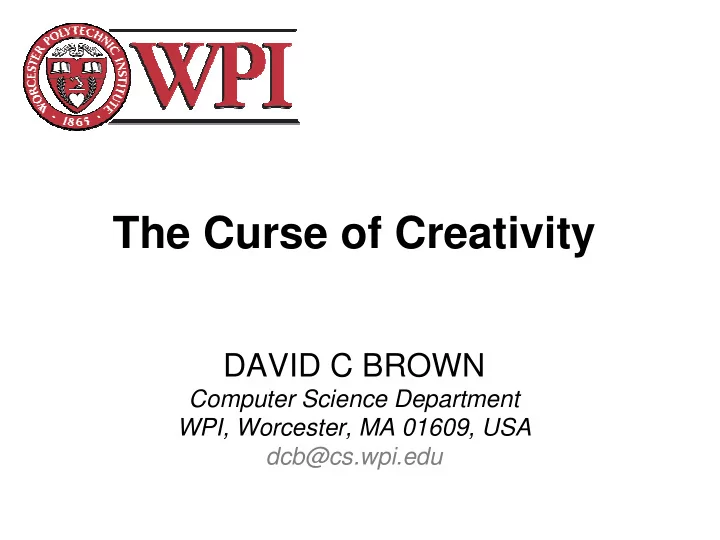

The Curse of Creativity DAVID C BROWN Computer Science Department WPI, Worcester, MA 01609, USA dcb@cs.wpi.edu
Motivation • Computational design creativity is hard to study. • The focus has been on extreme non-routine design cases. i.e., start with the hardest! blue sky research
Very Creative Artifacts
Very Creative Artifacts
“Theoretical” Creativity • Formal theory. • Conceptual space “transformed”. • Transformational creativity allows “radical newness”. – i.e., what wasn’t possible before.
“Perceived” Creativity • People detect and evaluate creativity. • Varies by who judges. • Judgment includes many factors. • People can judge degrees of creativity. …Exotic & extreme creativity. …Mundane creativity.
Exotic?
Mundane?
More Mundane?
Anti -blue sky • Start with the easiest! • Try to generate mundane creativity. • Gently transform routine design methods. • Investigate impact of changes on judgement of creativity.
Ingredients of Routine Designing 1-13 1. Basic Synthesis 2. Criticism 3. Decomposition 4. Evaluation 5. Execution 6. Ordering 7. Patching 8. Planning 9. Recomposition 10. Retraction 11. Selection 12. Situation Recognition 13. Suggestion Making
Ingredients in DSPL Basic Synthesis Step Criticism Constraint Decomposition Plan Task Step Evaluation Sponsor Execution Plan execution Ordering Plan Task Step Patching Redesigner Planning Plan Plan Sponsor Plan Selector Recomposition Plan . Retraction Backtracking Selection Plan Selector Step Situation Recognition Plan Sponsor Step FHs Suggestion Making Suggestion
Ingredients of Creative Reasoning A-Q A. Novelty B. Domain Knowledge C. Heuristic knowledge D. Constraints E. Combinations F. Associative reasoning G. Suppressing inhibitions H. Abstract and imprecise descriptions I. Alternative methods J. Critical assessment K. Problem recognition L. Concept expansion M. Analogical reasoning N. Visualization O. Meta-reasoning P. Least commitment Q. Forgetting
Matching creative and routine designing • Modify ingredients of routine design. • Consider 1-13 against A-Q. – Modify 1. Basic Synthesis to impact A. Novelty – e.g., Try avoiding common combinations of values • Assume no new design agents. • New mechanisms can be “called”. • Need to exploit meta-knowledge or meta-reasoning.
187 Possibilities for Modifications
Creative Design: Conclusions • Goal of transformational creativity is important. • Fuelled by large scale reasoning methods. – e.g., analogy. • But supported and enhanced by smaller scale reasoning. • Use Routine Design basis. • Focus on perceived creativity. • Many more opportunities for interesting research into creative design systems.
Ballpoint pen 1
Mundane Creativity? 4
Mundane Creativity? 5
Mundane Creativity? 6
Mundane Creativity? 10
Recommend
More recommend